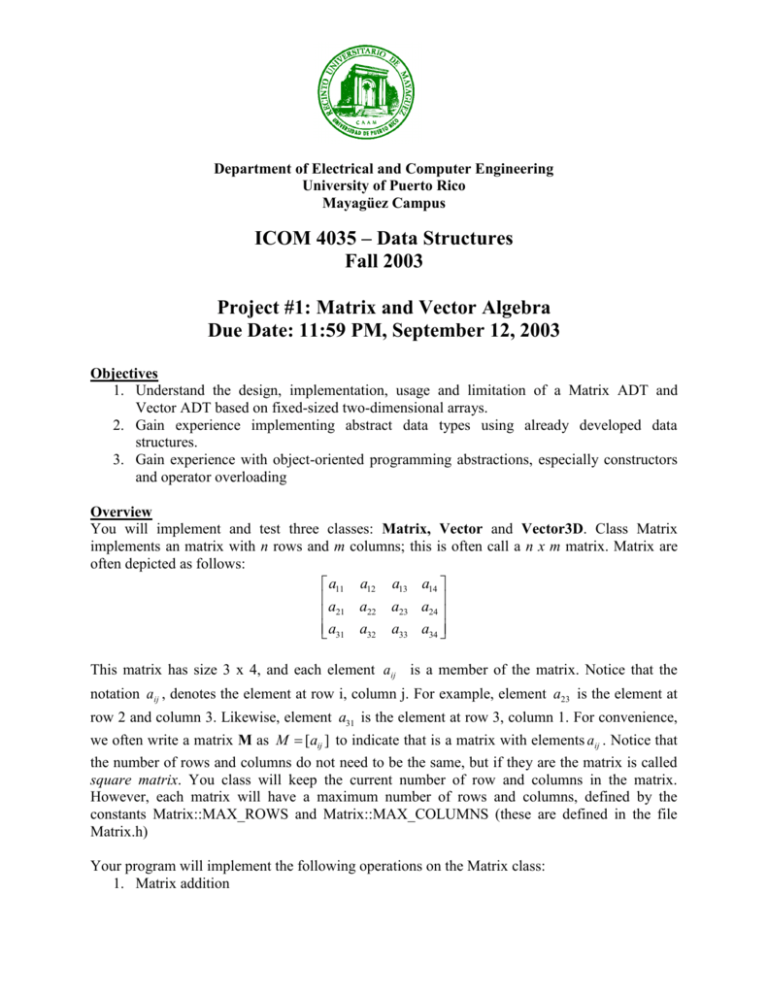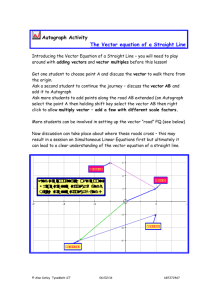Project #1 - Electrical and Computer Engineering Department
advertisement

Department of Electrical and Computer Engineering University of Puerto Rico Mayagüez Campus ICOM 4035 – Data Structures Fall 2003 Project #1: Matrix and Vector Algebra Due Date: 11:59 PM, September 12, 2003 Objectives 1. Understand the design, implementation, usage and limitation of a Matrix ADT and Vector ADT based on fixed-sized two-dimensional arrays. 2. Gain experience implementing abstract data types using already developed data structures. 3. Gain experience with object-oriented programming abstractions, especially constructors and operator overloading Overview You will implement and test three classes: Matrix, Vector and Vector3D. Class Matrix implements an matrix with n rows and m columns; this is often call a n x m matrix. Matrix are often depicted as follows: a11 a12 a13 a14 a 21 a22 a23 a24 a31 a32 a33 a34 This matrix has size 3 x 4, and each element aij is a member of the matrix. Notice that the notation aij , denotes the element at row i, column j. For example, element a23 is the element at row 2 and column 3. Likewise, element a31 is the element at row 3, column 1. For convenience, we often write a matrix M as M [aij ] to indicate that is a matrix with elements aij . Notice that the number of rows and columns do not need to be the same, but if they are the matrix is called square matrix. You class will keep the current number of row and columns in the matrix. However, each matrix will have a maximum number of rows and columns, defined by the constants Matrix::MAX_ROWS and Matrix::MAX_COLUMNS (these are defined in the file Matrix.h) Your program will implement the following operations on the Matrix class: 1. Matrix addition 2. 3. 4. 5. Matrix subtraction Matrix multiplication Matrix scalar multiplication Matrix transpose Each of these operations is defined below. Matrix addition Given two matrices A [aij ] and B [bij ] , then the operation A +B will produce a new matrix C [cij ] , where each value is computed as: cij aij bij . In this case, both matrices A and B must have the same numbers of rows and columns. Otherwise, you will program will throw an assertion. The resulting matrix C will have the same number of rows and columns as matrices A and B have. Matrix subtraction Given two matrices A [aij ] and B [bij ] , then the operation A -B will produce a new matrix C [cij ] , where each value is computed as: cij aij bij . In this case, both matrices A and B must have the same numbers of rows and columns. Otherwise, you will program will throw an assertion. The resulting matrix C will have the same number of rows and columns as matrices A and B have. Matrix multiplication Given a matrix A [aij ] , of size m x p, and a matrix B [bij ] , of size p x n, then the multiplication operation A * B will produce a new matrix C [cij ] , of size m x n, where each value is computed as: cij ai1b1 j ai 2b2 j ai 3b3 j ... aipbpj . In this case, the number of columns in matrix A (the value p) must be equal to the number of rows in B. Otherwise, you will program will throw an assertion. The resulting matrix C will have the same number of rows as matrix A (the value m) and the same number of columns as matrix B (the value n). Matrix scalar multiplication Given a matrix A [aij ] and a number r, then the operation r * A will produce a new matrix C [cij ] , where each value is computed as: cij r * aij . The resulting matrix C will have the same number of rows and columns as matrix A. Matrix transpose Given a matrix A [aij ] , of m x n, then the transpose of A, denoted as AT , is an operation that will produce a new matrix B [bij ] , of size n x m, where each value is computed as: bij a ji . Thus, the number of rows in B is equal to the number of columns in A, and the number of columns in B is equal to the number of rows in A. Vector class The Vector class is a class derived from the class Matrix. Vector implement the functionality of n-dimensional vector. An n-dimensional vector can be represented as a n x 1 matrix: a11 a 21 a31 a41 In this case, the vector is a 4 x 1 matrix, representing a point in a space with four dimensions. It is often convenient to express a vector V in terms of its dimensions: V = (a1, a2, …, an) The Vector class will have method to access and modify each of the components of its dimensions. In addition, the Vector class will implement the following operations: 1. Vector length 2. Vector inner (dot product) 3. Vector angle The semantics of these operations is defined as follows. Vector length Given a vector V = (a1, a2, …, an), the length of the vector, denoted by ||V||, is defined as: V a12 a22 ... an2 Vector inner (dot) product Given vectors V1 = (a1, a2, …, an), and V2 = (b1, b2, …, bn), the inner (dot) product between V1 and V2 , denoted as V1 V2 , is defined as: V1 V2 a1b1 a2b2 ... anbn Vector angle Given vectors V1 = (a1, a2, …, an), and V2 = (b1, b2, …, bn), the angle θ between V1 and V2 , is a number for which: V1 V2 cos( ) || V1 || || V2 || The number θ is called the arc cosine, or cosine inverse, and can be computed as follows: V1 V2 cos1 || V1 || || V2 || C++ provides a function called acos() than can be used to compute the arc cosine. Vector 3D Class The class Vector3D is derived from the Vector class, and it implements a vector in a three dimensional space. In this case, any instance of the Vector3D will have three dimensions, and hence is a 3 x 1 matrix: a11 V = a21 a31 For example, the points P1 = (1,0,1) and P2 = (1,0,0) are represented, respectively, as: 1 P 1 0 1 1 P2 0 0 In the Vector3D class, you will implement the cross product operator, and you will have two versions of it. The first version will be a member function that computes the cross product between two vectors v1 and v2, and assigns the result to v1. The second version will be a nonmember function that computes the cross product between v1 and v2, and then assigns the result to a new vector v3. Vector Cross Product Given vectors V1 = (a1, a2, a3), and V2 = (b1, b2, b3), the cross product between V1 and V2, denoted as V1 × V2 , is a vector V3 = (c1, c2, c3) such that c1 a 2 b3 a3b2 c2 a3b1 a1b3 c3 a1b2 a 2 b1 Distribution Files You can go to the class web page and download a tar file containing all the files related with this project. Just access the link named Projects, and download the sources files associated with the link: Project #1– Matrix and Vector Algebra. You implementation will consist of adding C++ code to implement three modules: Matrix.cpp, Vector.cpp, and Vector3D.cpp. You will receive all the .h files with declaration of the Matrix, Vector and Vector3D classes. In addition, you will be provided with a main program that uses the Matrix, Vector, and Vector3D classes, and interacts with the user to ask his/her input on the operations to be performed. Finally, you will be given a Makefile with all the commands needed to compile and submit your project. 1. Object.h – declaration of the Object type that will be stored in the matrix or vector. 2. Matrix.h – declaration of the Matrix class. 3. Matrix.cpp – implementation of the Matrix class. YOU MUST IMPLEMENT THE METHODS TO APPEAR IN THIS FILE. 4. Vector.h – declaration of the Vector class. 5. Vector.cpp – implementation of the Vector class. YOU MUST IMPLEMENT THE METHODS TO APPEAR IN THIS FILE. 6. Vector3D.h – declaration of the Vector3D class. 7. Vector3D.cpp – implementation of the Vector3D class. YOU MUST IMPLEMENT THE METHODS TO APPEAR IN THIS FILE. 8. matrix_main.cpp – main program to the Matrix, Vector and Vector3D classes. DO NOT MODIFY THIS FILE!!!! 9. Makefile – file with the commands to compile and submit you project. 10. test1.in – test input file 1. NOTE: YOU PROGRAM MUST PASS THIS FILE WITHOUT ERRORS IN ORDER TO BE CONSIDERED A RUNNING PROGRAM. 11. test1.out – expected output from test input file 1. 12. test2.in – test input file 2. 13. test2.out – expected output from test input file 2. 14. test3.in – test input file 3. 15. test3.out – expected output file from test input file 3. 16. prof_matrix_main – professor’s version of the matrix_main program. NOTE: Known to be working correctly. PROJECT DUE DATE: 11:59 PM – September 12, 2003.







